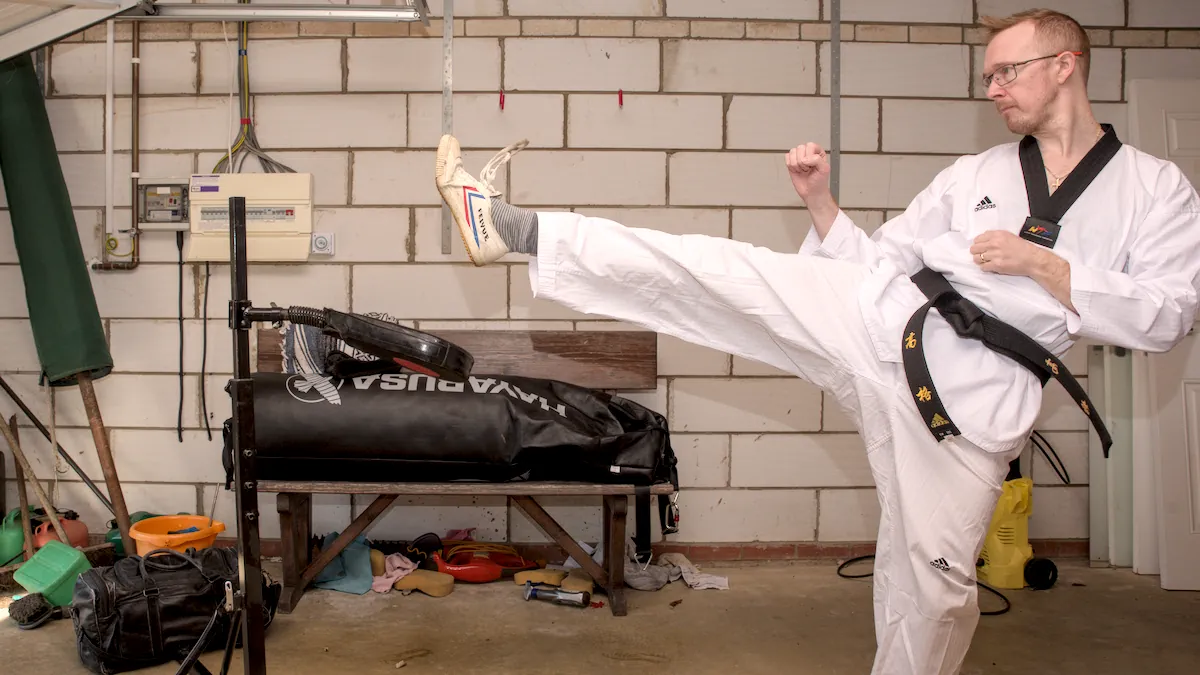This debate had raged in martial arts circles long before the internet existed. Bruce Lee mentions it in the 60s, “The Karate punch is like an iron bar, and it goes whack! But the Kung Fu punch is like an iron ball on the end of a chain, and it goes Whang! It hurts on the inside!” So which martial art is better? Karate vs. Kung Fu.
You might be trying to decide, “What martial art should I learn?” Start by comparing these two popular martial arts styles.
Defining Kung Fu is Tricky
Before starting to work out which martial art is better, we must know what we’re discussing. Kung Fu is not just another style of martial art like Taekwondo or BJJ. Instead, Kung Fu is a group of martial arts.
Any Chinese martial art can be called “Kung Fu,” In fact, in China, we use the word even more loosely to mean any developed skill. So when a guy came to my house a couple of years ago to drill into the ceiling of my gym and hang my heavy bag, he used a bag to catch all the falling dust. “Hao Gong Fu!” I said.
People in China are just as likely to say someone has kung fu for driving well or cooking tasty snacks as they are to say it about martial arts.
But let’s reign it in before we get too far off track; for the purposes of this discussion, “kung fu” simply means Chinese martial art. This is what most people mean when they use the term in English.
So what exactly are the Chinese martial arts?
Let’s split them up into three categories:
- Northern styles
- Southern styles
- Internal styles
Northern Kung Fu Styles
People from the North of China are notoriously taller than people in the south. Many people believe that this is the reason for the unique features of northern kung fu styles.
“Nan Quan, Bei Tui,” This common idiom describes well one of the key differences between northern and southern kung fu styles. It means “Southern fist, Northern leg.
The taller statures of the people in the north manifested in their martial arts with longer-ranged techniques such as kicks, wider stances, and long punches. You can see this clearly in the following northern styles:
- Shaolin Kung Fu
- Baji Quan
- Northern Preying Mantis
- Chang Quan (Long Fist)
Southern Kung Fu Styles
By contrast, Southern styles focus on short, sharp movements in upright stances that look more like professional combat sports today.
Wing Chun is by far the most well-known of the Southern styles, thanks partly to Bruce Lee and his master, Yip Man.
It’s thought that these shorter-ranged systems were more fitting to the shorter people of southern China.
Other Southern styles include:
- Southern Preying Mantis
- Choy Li Fut
- Hung Gar
Internal Chinese Martial Arts
The final piece of the Kung Fu puzzle is the internal arts; there are three, traditionally:
- Tai Chi (or taiji, taijiquan)
- Ba Gua Zhang
- Xin Yi Quan
Each of the internal arts involves cultivating qi to improve your martial effectiveness.
What Is Karate?
The definition of karate is much more narrow. It’s the name of one specific style of Japanese martial arts and is unique compared to the other styles on the island.
After initially developing in the Ryukyu Kingdom on the islands south of Japan and being influenced by some Chinese kung fu styles, possibly as early as the Tang dynasty, the art was finally named Karate in the 1920s.
Karate, which means “empty hand,” differentiated itself from many other Japanese martial arts as a style without weapons. Without training swords, karate became known as a martial art of self-defense rather than one of attack.
Karate became popular in the West in the 1960s, and early karate champions such as Chuck Norris made names for themselves in the first karate competitions.
Karate has very stylized katas or routines in which the practitioner throws punches, kicks, and blocks, seemingly at imaginary opponents, usually moving in straight lines.
Karate and Kung Fu Comparison Table
| Point of Comparision | Karate | Kung Fu |
|---|---|---|
| Country of Origin | Japan | China |
| Description | Combat Sport | Group of Related Martial Arts |
| Notable School | Shotokan | Shaolin |
| Notable Practitioner | Chuck Norris | Bruce Lee |
| Strikes | Hands and Feet | Hands, Feet, Elbows, Knees |
| Philosophical Association | Buddhist | Buddhist (zen or chan), Taoist |
| UFC Champions | ✔✔✔ | ✔ |
| Useful for MMA? | ✔✔ | ✔ |
| Useful for Real Combat? | ✔ | ✔✔ |
| Weapons | – | ✔✔✔ |
| Self Defence | ✔✔ | ✔✔✔ |
| Clear Progression (Belts) | ✔✔✔ | ✔ |
| Availability | ✔✔✔ | ✔ |
| Still Developing | ✔ | ✔✔ |
| A Complete System? | ✔ | ✔✔ |
What’s the Difference Between Karate and Kung Fu?
1. Karate is Clearly Defined
From the student who is looking for a new habit to improve himself’s point of view, karate is much easier to understand and to know what you’re getting yourself into. Any karate school you go into likely has the progression written up on their website or in print right there. You can see the katas, techniques, and skills you will learn as you go up the ranks.
There are a limited number of hand strikes and kicks that you’ll need to master and a ruleset that you must abide by.
But with kung fu, things are much more complicated. Aside from the northern and southern styles and the internal vs. external styles, there are weapons, animal styles, chi gong, and even secret forms that you could learn if you become an indoor student or disciple.
Additionally, there are uncountable hand techniques which often change according to different teachers in the same style!
For example, in karate, you have techniques called front kick and straight punch, while in Kung fu, you have techniques called “needles at the bottom of the sea,” “secret sword hand,” and “snake fist.”
2. Karate Has a Straightforward Progression
There’s nothing more iconic in martial arts than the karate belt. And there’s nothing better than seeing the pride on a child’s face when receiving a new belt.
Karate belts have a progression that’s easy to understand, even for children. A common karate belt order in many styles is:
- White Belt
- Yellow Belt
- Orange Belt
- Green Belt
- Blue Belt
- Brown Belt
- Black Belt
Some kung fu styles and schools may have a belt or colored sash system, but most don’t. The grading system wasn’t a part of traditional Chinese martial arts. I trained under Master Wang for years in Beijing, and there were no gradings, no certificates, no trophies, or colored belts. All I ever got were blue and purple bruises!
3. Karate Is More Widespread
You can find a karate class near you almost anywhere in the Western world. Every city and many smaller towns have karate masters teaching classes. This is in part due to the long history of karate, which came to the West earlier than kung fu. But also because kung fu was and still is largely locked up in China.
That’s not to say you can’t find a kung fu class near you, but if you want to study a particular style, such as Baji Quan, it will be much harder to find.
4. Kung Fu Is More Diverse than Karate
There is much more to learn when it comes to Chinese martial arts than simply studying karate. A better comparison would be kung fu vs. Japanese martial arts, including aikido, judo, jujutsu, kendo, and iaido.
Kung fu, because it encompasses so many styles, is much more diverse than karate. Kung fu includes:
- Weapons
- Chi Gong
- Iron Body Skills
- Grappling
- Joint Locks
- Animal Styles
- etc.
Kung fu includes all the techniques of karate (many of which came from the Kung Fu styles of Fujian, such as white crane style) and many, many more.
5. Kung Fu Is Still Evolving
Despite being much older than karate, kung fu is arguably developing much faster than its Japanese counterpart.
While many karate schools operate much in the same way as they did decades ago, kung fu schools (especially in China) have gone through a huge amount of change.
Styles such as Kyokushin karate are developments that make karate more useful for combat, with full contact sparring for example. But even this “newer” style is now over 60 years old. It was originally developed in 1957.
In the 1980s, it would have been commonplace to see students at Shaolin using traditional training methods such as “splashing hands” and “striking sand,” nowadays, most students and even Shaolin monks (e.g. Shi Yanzi of the UK Shaolin Temple) spend their time hitting heavy bags or pads, training for kickboxing or MMA tournaments.
Both students and teachers realize the need to evolve the style, which is what Shaolin Kung Fu has always been about. A place of trading techniques and styles.
6. Kung Fu Is More Secretive
Secret “indoor” techniques and deadly pressure point strikes make for a great kung fu movie, but in practice, it can be disheartening for students.
Many twice-a-week students or students who learn martial arts at home feel that they will never learn the whole art, and others may feel that the teacher or master is hiding things from them or even lying about the style. None of these situations make for a good learning environment.
Karate vs. Kung Fu in MMA
Let’s look at the UFC for examples of karate and kung fu fighters.
Karate Fighters in the UFC
- Stephen “Wonderboy” Thompson
- Liota Machita
- Georges St-Pierre
Kung Fu Fighters in the UFC
- Zhang Weili
- Cung Li
- Li JinLiang
There are certainly both karate and kung fu practitioners competing at the highest level in MMA, but there are significantly more with a karate background than a kung fu background. And among champions, there is only one relatively recent kung fu artist, Zhang Weili, whereas karate champions in the UFC go back decades.
This could be because karate is much more accessible in America and other Western countries, although there is another reason, the rise of sanda.
The three kung fu fighters above have a background in Sanda, not traditional kung fu. Sanda is also called Chinese Kickboxing and is relatively unknown in Western countries. As a teenager, I trained in Sanda for many years, and due to the lack of other clubs nearby, we would have to compete in regular kickboxing competitions. But as Sanda is so similar to Western kickboxing, it made little difference to us.
The other style many kung fu fighters in professional MMA have in common is Shuai jiao, Chinese wrestling.
There are no wing chun, praying mantis, tai chi, or other traditional kung fu fighters at the highest level of professional combat sports.
So Karate takes the Win here. There are more karate fighters, and they learned actual traditional karate.
Kung Fu vs. Karate for self-defense
When defending yourself in a street fight or other physical encounter, would you be better off knowing kung fu or karate?
Let’s look at four factors.
1. You Don’t Get to Choose the Location of a Fight
Karate, with its high stances, reliance on jumping out of the way of attacks at its long-range techniques such as kicks isn’t suitable in some locations. For example, while karate might be ideal outside with plenty of space, in a small room with many obstacles or people in the way, karate won’t perform well.
By contrast, many of the southern kung fu styles thrive in this kind of environment. For example, people describe Wing Chun as the art of fighting in a phone box. Attacks are evaded with just the turning of the feet and the extending of the arms; similarly, strikes with hands and feet are measured, never over-extending or causing the fighter to become unbalanced.
2. All Fights End Up on the Ground
You often hear from jiu-jitsu practitioners that all fights end up on the ground, which is an excellent reason to have a solid ground game. So in a street fight that’s bound to end up on the floor, who is better off, karate or kung fu?
We practiced throws, takedowns, and breakfalls in every class when I trained Sanda. Although we rarely continued when on the mats or practiced submissions, chokes or arm bars, etc., Part of being taken down is getting back up. So while neither fighter would have much of an advantage on the ground, the kung fu fighter would probably be able to get back up onto his feet and continue, which might be the difference in a real fight.
3. The Lack of Sparring in Kung Fu
Aside from learning sanda, I also spent years learning traditional kung fu styles such as Shaolin, wing chun, and tai chi (both Yang and Chen styles.) I trained with kung fu teachers in the UK and China, and the one thing traditional kung fu styles lack is sparring.
When you ask about it, there are a few common responses:
- It’s too dangerous
- It’s not a sport like karate, so there’s no way to practice safely
- The gloves and protective equipment make too many techniques impossible
But without sparring, putting yourself in a combative situation, and testing yourself against an opponent, you don’t gain the experience and skill to use what you’re learning. For example, if you had never shot a gun at a target before, would you expect to hit an enemy the first time you tried?
On the other hand, sparring in karate classes is very common. Some schools spar every class! Karate also has a tradition of full-contact competition, which is a safe way to test yourself.
4. Sport vs. Combat
One thing you will often hear both students and kung fu masters say is that kung fu is meant for real fighting and actual combat, whereas styles like karate and taekwondo are sports with rules and regulations.
There are pros and cons to being a sport vs. a martial art.
Karate is now an Olympic sport which means you can compete at levels all the way up to the Olympic stage with karate. It also means you have more opportunities to enter kumite or tournaments and test out your skills.
If you are training in kung fu, you will most likely need to compete in kickboxing competitions or MMA because there are very few organized kung fu competitions.
There’s Something More Important Than Styles
There’s a reason that every professional combat sport has weight classes!
There are some factors that trump styles, weight is one of them, and individual differences are even more important. Some people are so athletic, strong, and aggressive that they can be successful no matter which style they learn.
Similarly, if you are timid, fearful, and unwilling to engage in a fight, it won’t matter whether you study karate or kung fu. You won’t be successful.
Styles don’t make champions. You have to do that yourself.
If you’re still unsure whether to join a karate class or a kung fu class, here’s the best advice I can offer you. Go try a class or two and see which you prefer.






